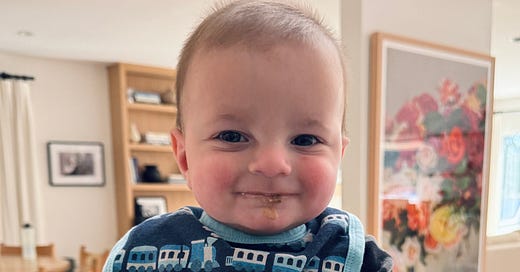The First 5 Things I Fed Finn (and Poppy)
A Guide to Starting Solids with Confidence + Our Pediatrician’s Top 5 Rules
Today’s Substack is a little longer than what I envision moving forward, but for good reason—we’re diving deep into starting solids with confidence. I wanted to cover all the basics so you feel fully equipped with the info you need, whether you're just beginning this journey or looking for a solid (pun intended) refresher. Think of this as a go-to reference, something to come back to whenever you need a little guidance. Let’s get into it!
Let’s Start with the Basics
When Are Babies Ready for Solids?
Most babies are ready around 5-6 months, but some earlier or later. Key milestones to look for:
Sitting up with minimal support – Poppy was fully sitting at 6 months, while Finn still needs a little help. Because of that, we’re very hands-on during mealtimes and try to feed him when both Thomas and I are home—one of us helps him stay upright so he doesn’t face-plant into his food (or the counter).
Good head control – Your baby should be able to hold their head up steadily.
Showing interest in food – Both Finn and Poppy started reaching for bananas around 5 months, which was my cue that they were ready to start exploring solids.
Every baby moves at their own pace—watch for these signs and trust your gut!
Choosing a Feeding Approach:
Purees, progressing to chunkier textures. This method of introducing solids to babies involves offering smooth, blended foods by spoon before progressing to more textured foods. Parents typically start with single-ingredient purées and gradually introduce combinations and thicker textures as the baby develops
Baby-led weaning (BLW). BLW is a method of introducing solid foods to babies that skips traditional spoon-feeding with purées and instead encourages self-feeding from the start. With BLW, babies are offered appropriately sized and textured finger foods that they can grasp, explore, and eat at their own pace. This approach promotes independence, fine motor skills, and helps babies learn to chew and manage different textures early on. It also allows them to participate in family meals by eating modified versions of what the rest of the family is having.
A combo of both.
There’s no right way—just the way that feels most comfortable for you and your baby!
What We Did…
Keep reading with a 7-day free trial
Subscribe to Little Mouths, Big Palates to keep reading this post and get 7 days of free access to the full post archives.





